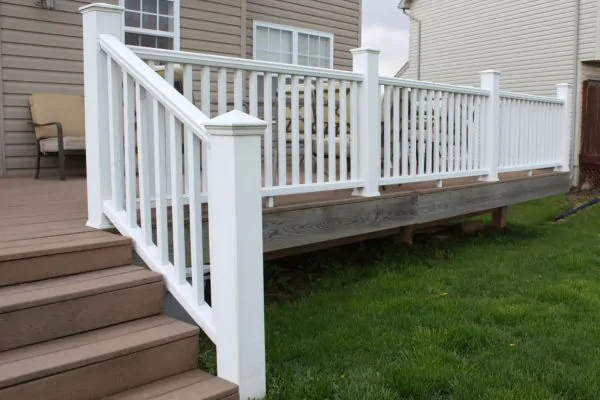
Deck railings merge safety and style, offering a protective barrier against accidental falls and elevating the visual charm of outdoor spaces.
Whether crafted for privacy, adopting modern aesthetics, or simply adhering to compliance, these structural elements are a key consideration in deck design.
Balancing function with form, they serve as a canvas for creativity, allowing homeowners to infuse their taste through myriad design choices and materials.
The journey begins here for anyone eager to transform their outdoor living area with innovative ideas for deck railings.
Keep reading for a wealth of information on selecting and installing the perfect deck railing that resonates with your safety needs and stylistic preferences.
Deck Railing Essentials
A deck serves as a blueprint for outdoor leisure and a statement of style and safety commitment. Deck railing essentials focus on complying with municipal codes while infusing individual taste through materials and design.
Mastery over regulations ensures a secure environment, emphasizing height and spacing alignments. The journey through materials reveals wood’s grace, metal’s strength, glass’s clarity, and composite options’ resilience—each balancing robust safety with elegant design.
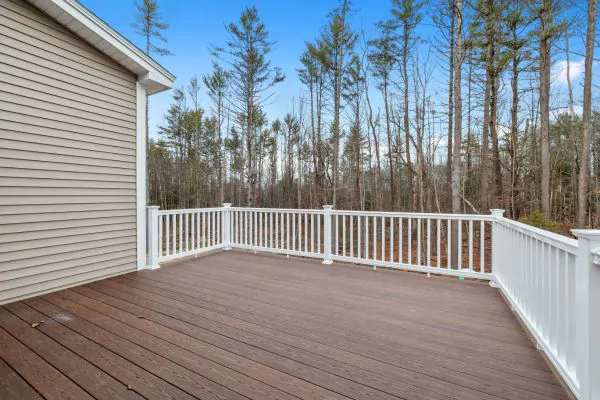
Functional considerations, including cocktail railings, enhance utility and enjoyment, ensuring a cherished haven for solace and socialization.
Regulations
Deft navigation through the labyrinth of building codes sets the stage for deck railings that ensure safety and reflect the care-infused handprint of a homeowner’s aesthetic choices. Height and spacing guidelines form the invisible steel within the concrete of safety standards, preventing missteps and safeguarding well-being with a precision that quietly underpins the joy of outdoor living.
Materials and Styles
In deck railings, a diverse material palette offers a nuanced blend of form and function. Wood exudes warmth and timeless charm, metal epitomizes strength and sleek lines, while glass provides an unobstructed view.
Composites blend enduring beauty with low maintenance. Striking the right balance between safety and aesthetics is key in deck design. Beyond material choice, the railing’s style elevates it into sophisticated architecture.
Whether nestled in greenery or making a bold statement against the sky, deck railings should seamlessly integrate with surroundings, enhancing safety and character in outdoor spaces tailored to personal tastes.
Safety and Practicality
In crafting deck railings, homeowners meticulously consider functionality and safety, seeking a harmonious blend.
The essence of a deck lies in the convergence of strict safety adherence and the art of daily living—a space where functionality and aesthetics unite to create a secure, inviting atmosphere.
The rise of cocktail railings reflects this blend, seamlessly merging pragmatic design with leisurely charm.
These railings epitomize modern outdoor design’s innovative spirit, transforming a safety feature into a focal point for shared moments and cherished conversations, providing a broad, flat surface for social gatherings.
How much does a deck railing cost?
Embarking on the construction or renovation of a deck often begins with merging safety standards and aesthetic preferences. Yet, budgetary constraints undeniably play an instrumental role in influencing the outcome.
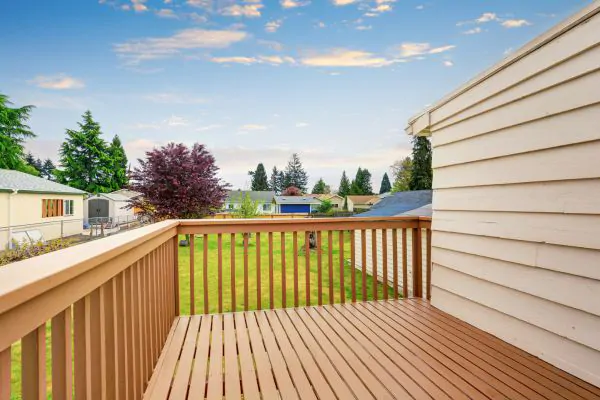
The anticipated discussion on deck railing costs necessitates a comprehensive analysis, considering the myriad factors directly impacting financial outlays.
This encompasses thoroughly exploring material options and intrinsic properties, and determining initial expenses and long-term investment value.
Equally imperative is articulating strategies for effective budgeting, addressing the palpable cost of materials and the often-overlooked expenses entwined with installation and ancillary requirements.
A. Comparison
Cost analysis is crucial when considering deck railing investment, extending beyond material prices to include installation intricacies and long-term maintenance. Factors influencing expenses go beyond material choice, encompassing design complexity, customizations, local labor rates, and project scale.
These elements shape the financial blueprint, urging homeowners to approach budgeting for deck railings with a strategic and well-informed mindset.
B. Budgeting
When selecting materials for deck railings, one contemplates durability, style, and economic implications. Choices range from economical pine to upscale glass and composite solutions, each bearing a different price tag reflective of their unique attributes and lifespan.
Installation and ancillary costs present a landscape of expenditures where the intricacies of labor, the necessity of tools, and the potential need for ongoing maintenance blossom into crucial considerations that must be strategically planned to align with financial resources and project timelines.
Designing and Installing
Designing and installing deck railings is critical, weaving together safety and aesthetic value. Meticulous planning is required to ensure post spacing aligns with safety guidelines and building codes, forming the structural backbone of any railing system.
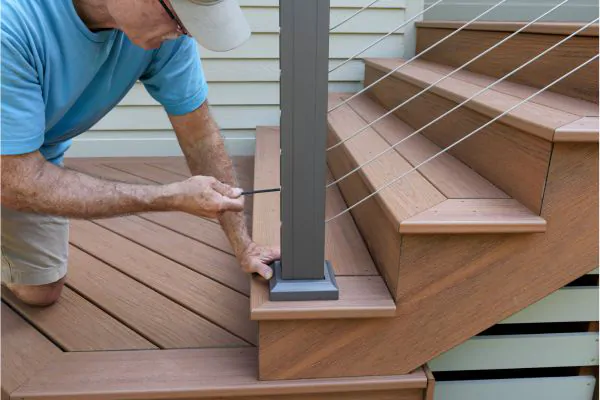
A step-by-step installation approach focuses on crafting a durable structure that withstands the test of time and weather. Maintenance, often overlooked but vital, preserves both functionality and beauty.
Cable deck railings, requiring precision in installation and vigilant upkeep, highlight sleek appearance and structural integrity.
Including cocktail railings contributes creative and practical design solutions that align with modern outdoor living trends.
A. Post Spacing
In the realm of deck construction, the precise computation of post spacing is non-negotiable; guidelines stipulate the intervals at which support posts must be situated to maintain the structural integrity of the railings and, by extension, the deck’s safety.
Adherence to building codes not only guards against structural failure but also reinforces public confidence in the safety of deck environments, mandating that post placements are not left to arbitrary discretion but are aligned with the rigor of established safety parameters.
B. Installation Steps
Embarking on the installation of deck railings encompasses a meticulous blend of precision and attention to detail, ensuring each step, from measuring to securing posts and panels, adheres strictly to design plans and codes. The step-by-step guide involves methodically laying the groundwork for supports, attaching the rails, and ensuring all fixtures and fastenings are secure, establishing a deck that captivates the eye and endures as a paragon of safety.
Post-installation, the emphasis on maintenance ascends as a critical factor in safeguarding the long-term integrity and aesthetics of the deck railing system. Regular inspections and care, particularly for materials susceptible to environmental wear, such as wood and metal, sustain the railing’s reliability and charm, affirming the homeowner’s investment in quality, appearance, and unwavering safety.
C. Cable Deck Railings Safety
The safety of cable deck railings hinges on the meticulous execution during their installation and the commitment to ongoing maintenance. Ensuring the tension of the cables remains consistent and the fixtures are secure, requires vigilance and an understanding that even the most robust materials are subject to the whims of time and climate.
Meanwhile, cocktail railings present intriguing insights into the evolving nature of deck design; they underscore an awareness that modern outdoor spaces are not just about aesthetics but the integration of functionality, where social interaction and safety coalesce to foster an inclusive conviviality.
V. Reasons to Install Deck Railing
Deck railing installation takes center stage in outdoor space enhancement, blending safety measures with visual appeal.
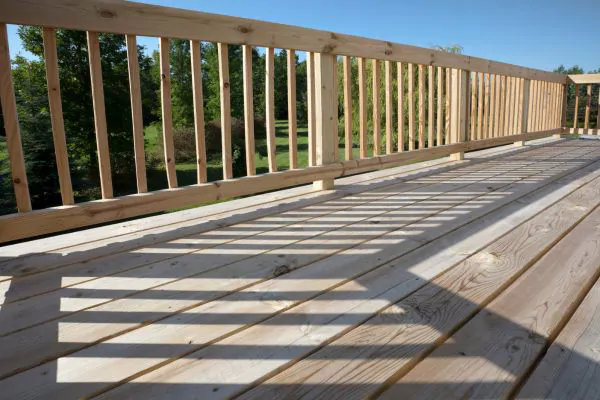
As homeowners prioritize securing their surroundings, deck railings become a tangible expression of care, extending beyond decoration to instill peace of mind through accident prevention and adherence to stringent building codes.
This commitment enhances property value, positioning railings as brushstrokes on a home’s aesthetic canvas, and heightening allure to prospective buyers.
Beyond pragmatism, deck railings invite personalization, enabling decorative flourishes and custom touches that reflect the homeowner’s unique style and functional preferences.
A. Safety and Compliance
Deck railings are a crucial safeguard, effectively preventing accidents and falls from elevated platforms.
A robust railing system acts as a physical countermeasure, enhancing outdoor spaces with a layer of security for tranquil enjoyment. Compliance with building codes is a legal obligation and a discerning embrace of community-established wisdom that underlines public safety.
Deck railings designed to these standards represent the homeowner’s pledge to quality craftsmanship and collective well-being, ensuring elevated outdoor retreats adhere to the highest security protocols.
B. Property Value
Deck railings contribute to a home’s visual harmony, as an architectural highlight that elevates outdoor living spaces through design and craftsmanship.
Shrewd homeowners recognize their stylistic impact, transforming a deck into a visually appealing feature with architectural coherence. From a real estate standpoint, well-designed railings can spike buyer interest, positioning a property as a standout contender.
A secure and stylish outdoor space’s intrinsic value is a compelling enticement for buyers seeking a home with ready-made charm and utility.
C. Functionality
Embracing the decorative elements within deck railings infuses the space with personality and artistry. Installing intricate scrollwork, contemporary patterns, or even classic balusters turns a practical feature into a visual feast, elevating the ambiance of the outdoor setting. Personal customization enables homeowners to imprint their decks with distinctive flair, ensuring that the railing design resonates with the home’s character and the owner’s individual style narrative.
Related Post: Time To Build A Deck: How Long Does It Take?
Considerations When Choosing
As they enhance outdoor spaces, homeowners face a pivotal decision in choosing deck railings, balancing safety, materials, and style considerations.
Safety is paramount, focusing on selecting robust railings meeting regulatory demands for stability. Simultaneously, the decision involves evaluating materials like wood, metal, glass, and composite, each with unique maintenance and longevity considerations.
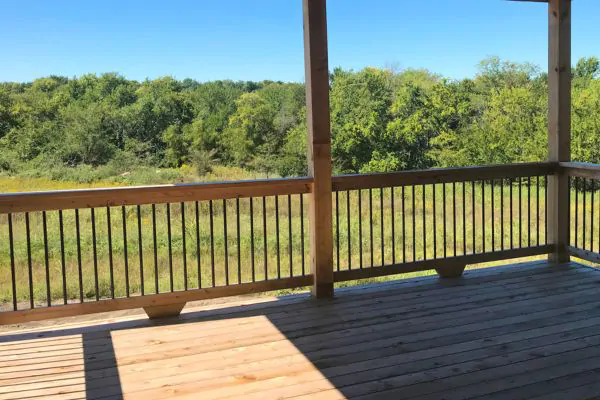
Balancing practical needs with aesthetic desires, individuals harmonize choices with home architecture and budget, ensuring a cohesive design without sacrificing quality for cost-effectiveness.
This intricate decision-making process reflects a marriage between form and function, creating not just a barrier but an integral component of the home’s architectural narrative.
A. Safety First
In crafting an outdoor sanctuary, homeowners prioritize robust and stable deck railings, ensuring durability and unwavering support against nature’s elements.
Decks serve as thresholds between domestic comfort and the outdoors, demanding sturdy railings to protect and delineate this boundary confidently. Selecting deck railings aligns with meticulous compliance with regional building regulations, ensuring every safety barrier meets exacting standards to prevent mishaps.
Adherence to regulations reflects the homeowner’s commitment to public safety, marrying civic responsibility with personal assurance.
B. Materials and Maintenance
Decision-making concerning deck railings unfurls into a scrutiny of materials with diverse traits and upkeep demands.
Wood enchants with its organic allure, yet calls for periodic treatment to stave off decay; metal stands as a paragon of sturdiness with minimal care, although certain types may necessitate a vigilant stance against rust; glass proffers an elegant transparency, albeit with the caveat of consistent cleaning to preserve its pristine look; and composite materials marry the aesthetic grace of wood with a robust nature that sidesteps frequent maintenance.
Owners must weigh these options, considering their readiness for sustaining the railing’s appeal and structural soundness over time.
C. Style and Harmony
Choosing deck railings that seamlessly integrate with a home’s architecture involves a craft that blends subtlety with intentional design.
Homeowners seek railings that resonate with their houses’ architectural periods and design motifs, ensuring a seamless transition between the interior and the outdoor oasis.
Cost-conscious homeowners explore budget-friendly deck railing options without compromising on style or quality.
Innovative materials and manufacturing techniques enable savvy individuals to achieve desired aesthetics and durability, ensuring safety and elegance on a tighter budget.
VII. Deck Railing Ideas for Inspiration
Reimagining deck railings allows homeowners to express creativity while fulfilling functional necessities with stylish solutions. Beyond mere safety barriers, deck railings become elements of profound aesthetic significance, offering opportunities for innovative expression.
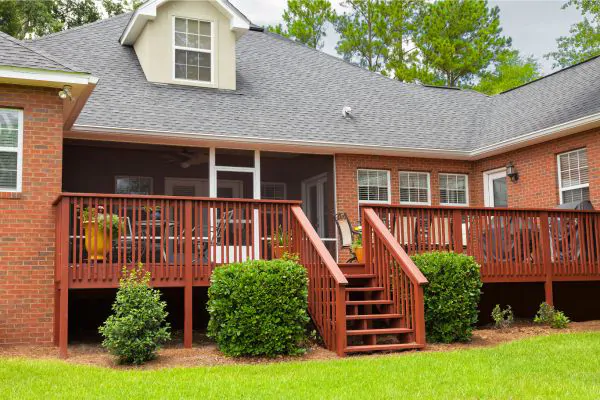
Discerning tastes lean towards minimalist cable railings, glass railings for modern design, and combinations of metal and wood for versatility. The inclusion of planters introduces a living aspect, blending greenery and functionality.
Each concept transforms deck railings into a testament of personal style and thoughtful design.
A. Cable Railings
Cable railings embody an essence of sophistication, their slender lines offering an uncluttered view that enhances the sense of space within the deck area.
This design choice is celebrated for its modern appeal, balancing open vistas and necessary safety.
Exploring the realm of material variations, cable railings present a versatile platform for customization, drawing from a spectrum of metals such as stainless steel or aluminum to cater to differing tastes and environmental conditions.
The adaptability in material selection allows for a tailored approach, ensuring the railing system complements the home’s aesthetic and stands as a testament to resilience and quality craftsmanship.
B. Glass Railings
Glass railings embody the fusion of modern taste and architectural transparency, providing sleek profiles for an unbroken view of surroundings.
Their rise in contemporary design stems from their ability to infuse spaces with lightness and a futuristic edge, where light and landscape are essential design elements.
Integrating glass railings requires unwavering attention to safety, ensuring shatter-resistant materials are firmly anchored to withstand elements and usage.
Balancing ethereal beauty with practical safety measures, these railings fortify a reassuring barrier without compromising modern design principles.
C. Metal and Wood Combinations
Metal and wood combinations in deck railings effortlessly bridge classic elegance with modern strength, offering diverse design possibilities to homeowners. The warmth of wood paired with the industrial chic of metal can evoke the charm of traditional spaces or pivot towards cutting-edge contemporary aesthetics, making this pairing highly adaptable to a spectrum of architectural styles.
D. Planters in Railings
Incorporating planters into deck railings introduces a verdant twist to the structural elements, marrying form with function as they breathe life into the deck’s aesthetic. This integration fulfills a dual purpose, elevating the design beyond its safety role by infusing the space with natural vibrancy and contributing to a serene environment.
Deck railings with integrated planters serve as sturdy barriers and dynamic showcases for botanical displays, offering a unique opportunity to frame outdoor vistas with seasonal blooms or evergreens. These living installations provide practical decor solutions, transforming railings into immersive garden experiences that enhance beauty and biodiversity within an arm’s reach.
You might ask: How Much Does It Cost To Build A Deck
VIII. Designing Your Deck Railing
Designing a deck railing system entails a journey into compliance, aesthetics, and functionality, pivotal for enhancing outdoor living spaces.
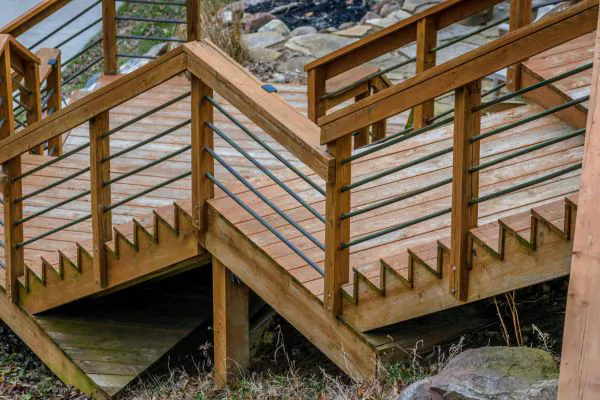
Crafting a visually stunning perimeter must align with rigorous safety standards and understanding specific building codes for height and spacing.
Exploring suitable materials and styles requires discernment, poised to complement the residence’s architectural narrative.
Layout planning strategically places rails and navigates potential obstacles. With precise measurements and materials, a comprehensive design plan emerges, including visualization sketches for structure visualization.
This meticulous preparation ensures securing permits and enlisting professional installation services, advancing the deck railing project precisely and adhering to regulatory and aesthetic requirements.
A. Meeting Requirements
Understanding building codes is essential in deck railing design, ensuring a secure structure and legal validity for outdoor boundaries.
A comprehensive grasp of regulations ensures railings protect against falls and adhere to local governance, specif
In deck design, meticulous consideration of height and spacing guarantees safety without obstructing views.
Precise adherence to specifications anchors the deck’s security in carefully calibrating these fundamental elements, establishing a balance between safety and aesthetics.
B. Material and Style Choices
Choosing deck railing materials requires a balance between enduring performance and architectural congruity.
Options include natural wood aging gracefully, low-maintenance composites, and sleek metals or clear glass for contemporary appeal. Aligning railing styles with a home’s architecture involves echoing design elements like color and texture.
Whether seamlessly extending the home’s character or making a contrasting statement, selecting styles resonating with the home’s aesthetic ensures a harmonious and visually coherent outdoor space.
C. Layout Planning
Deck railing design’s art lies in precise layout planning, requiring judicious rail placement for optimal safety and visual appeal. Strategic railing positioning creates an unobstructed flow, complementing the deck’s dimensions and enhancing overall functionality.
Overcoming deck design obstacles, from uneven terrains to architectural features, demands a creative yet systematic approach, ensuring the finished product is both a safe zone and an aesthetic triumph.
D. Comprehensive Design Plan
A deck railing’s secure blueprint hinges on a comprehensive design plan that harmonizes precise measurements and suitable materials.
Determining the correct dimensions in the planning phase ensures the railing complements the living space while meeting safety requirements.
Visualization sketches aid accurate conveyance to builders, allowing critical evaluations and adjustments before the physical work begins, aligning the final structure with homeowner aspirations and functional prerequisites.
E. Permits and Installation
Securing necessary permits before installing deck railings is not merely a bureaucratic formality; it is a crucial step that affirms compliance with local zoning laws and safety standards.
Enlisting professionals’ services for installing deck railings ensures a precision-oriented approach that leverages expertise and experience to achieve a seamless and secure addition to any outdoor space.
Best Materials for Deck and Porch Railing
Selecting railing material is a crucial aspect of home design, balancing safety with aesthetics.
Whether it’s timeless wood, modern metal, enduring composite, sleek glass, or minimalist cable, each option has unique care requirements, costs, and safety considerations. This deliberation shapes the tactile texture of daily life and the ambient personality of the home.
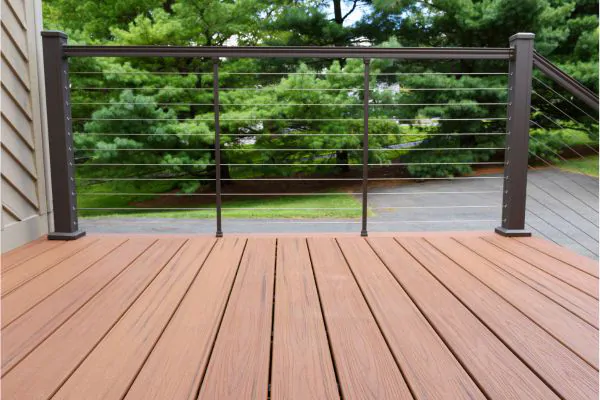
Homeowners navigating these decisions will find the following sections illuminating distinctive qualities and practical implications, guiding the integration of these materials into a well-conceived, harmonious outdoor space.
A. Wood
The allure of wood as a material for deck railings endures due to its quintessential and adaptable appearance, effortlessly imparting a sense of traditional elegance or rustic charm to outdoor spaces. Yet the choice of wood demands a proactive stance on maintenance, as the natural material requires regular sealing and staining to thwart deterioration from weather and wear, ensuring its aesthetic appeal and structural integrity remain intact for years.
B. Metal
The sleek sophistication of metal deck railings offers an undeniably modern appeal, their clean lines and reflective surfaces contributing to a contemporary aesthetic that complements a range of architectural styles. Durability is a hallmark of metal options, minimizing the need for frequent maintenance while ensuring lasting resilience against the elements, a trait that harmonizes handsomely with their initial investment, often higher than other materials. As homeowners consider the long-term implications of their choices, metal railings stand out as a premier selection for those seeking a blend of timeless elegance and enduring strength.
C. Composite
Composite materials emerge as the pinnacle of convenience for homeowners seeking a harmonious blend of durability and minimal upkeep in their deck railings. Their engineered composition resists common maladies that afflict more traditional materials, such as rot and insect damage, significantly reducing the time and expense dedicated to maintenance. When longevity is a paramount concern, composites offer an investment that endures, albeit with a higher upfront cost, offset by their extended lifespan and the preservation of aesthetic quality.
D. Glass
Glass railings, with their sleek profiles and unimpeded views, serve as a beacon of contemporary design, elegantly enhancing decks with a touch of sophistication that’s both visible and vital. While glass options may command a higher cost, their ability to preserve sightlines and foster a sense of openness anchors their value in both architectural beauty and functional longevity.
E. Cable
Cable railing for decks exudes unpretentious aesthetics, gaining popularity for seamlessly blending with the environment. Their minimalist design allows the surroundings to shine. Ensuring the integrity of cable railings requires precise installation and ongoing maintenance. Professional installers bring precision, crafting a system that offers subtlety and robust protection, aligning with safety standards.
Compliance with Building Codes
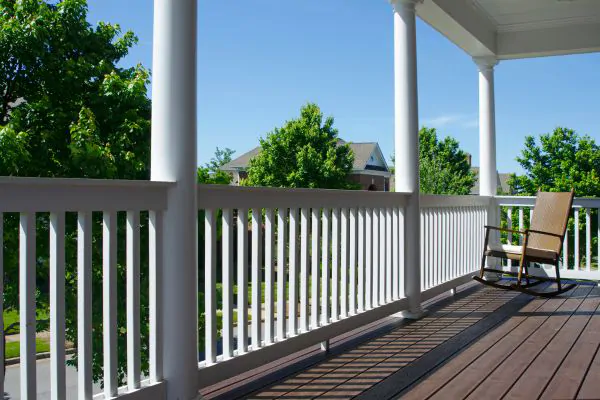
Building codes play a pivotal role in deck railings by blending safety with aesthetics. Stringently crafted for well-being, these codes prevent accidents and carry legal and insurance implications.
Compliance weaves through responsibility, enhancing home marketability and meeting insurers’ criteria. The journey to permit acquisition poses a labyrinth, sparing homeowners from legal infractions.
This introduction encapsulates safety, value enhancement, and legal fidelity in building code compliance for deck railings.
A. Safety Priority
Proactive compliance with building codes encapsulates a commitment to safety, rigorously calculated to prevent accidents by enforcing standards that detail the required strength and height of deck railings to guard against falls. The nuances of these regulations extend to legal and insurance domains, where adherence mitigates liability and harmonizes with the criteria set by insurance companies to reduce risk and ensure homeowner coverage is in good standing.
B. Property Value and Insurance
The valuation of a property often elevates with the integration of deck railings that strictly adhere to building codes, reflecting an investment that marries safety with attractive design to potential buyers and appraisers.
Conforming to insurance requirements with properly installed deck railings reinforces coverage eligibility, ensuring that homeowners can secure protection against liabilities associated with deck-related accidents or damages.
C. Permitting and Legal Compliance
Navigating deck railing permits demands understanding local regulations, requiring meticulous research and liaising with authorities. The successful acquisition aligns each addition with community standards, ensuring legitimacy and safety compliance. Meticulous code adherence not only preserves design integrity but secures investments against costly repercussions.
XI. Understanding The Use of Deck Railings
Navigating deck railing nuances involves balancing functionality with visual grace. Acute discernment of traffic flow and material durability ensures railings withstand daily life while preserving vistas.
Insights from professionals align pragmatic considerations with seamless design integration, supporting the safe and elegant extension of domestic life into the natural world.
A. Considering Traffic and Material
In calibrating deck railing materials, homeowners must contemplate the expected traffic their decks will endure, as certain materials are better suited to high activity levels. Metals such as aluminum and wrought iron, renowned for their tenacity, are ideal for decks hosting frequent gatherings, promising stability and reduced wear over time.
B. Preserving Views
Preserving the panoramic beauty of a scenic backyard or the expansive azure of a clear sky, deck railings with unobstructed views have become pivotal for homeowners who cherish their visual connection to the outdoors. Infills and brackets play a critical role, requiring strategic selection and placement to ensure maximal transparency and safety, allowing deck spaces to function as serene lookouts to nature’s splendor, without the compromise of bulky barriers.
C. Consulting Home Improvement Professionals
Professionals in deck railing installation bring expertise to seamlessly meet functional and aesthetic requirements. Consultations unveil opportunities for bespoke design elements, ensuring safety and visual appeal. Seasoned designers provide an online resource, aligning projects with the latest trends and practices. Their input aids in navigating code regulations and selecting materials that match the intended use and style.
Optimal Height for Deck Railing
Determining the optimal height for deck railings is a pivotal juncture, balancing safety and aesthetics.
This critical feature strikes a delicate balance, safeguarding against falls while enhancing property appeal. Regulatory standards dictate clear parameters, ensuring safety without compromising deck design integrity.
Navigating this interplay forms the essence of crafting functional railing systems that reflect a homeowner’s stylistic preferences.
A. Regulatory Standards
In deck railings, optimal height is a critical measure, guided by strict residential and commercial safety guidelines.
Balancing the non-negotiable altitude mandated by regulations with the pursuit of visual finesse ensures utilitarian requirements meet the aesthetic coherence of outdoor living spaces.
Achieving an optimal deck railing height demands finesse, balancing the essential protective function with the perpetual pursuit of an artful domicile.
Architects and builders must heed local code-prescribed heights while maintaining visual continuity to uphold the deck’s stylistic integrity.
Does Your Deck Need Railings?
A deck isn’t just for leisure but a crucial aspect of safety and architectural character. The question arises: “Does your deck need railing?” Regulatory compliance isn’t just about legal standards but defense against mishaps. Height requirements, steadfast regulations, and safety considerations highlight the dual purpose of structures—protection and enjoyment. Understanding this relationship between rule adherence and well-being is essential.
Deck railing installation transcends mere aesthetic enhancement, stepping firmly into safety compliance, where municipal codes steadfastly dictate height requirements.
A well-executed deck railing affirms adherence to these stipulations, prioritizing the prevention of accidents through structural barriers meticulously calibrated to an ideal elevation, effectively safeguarding users from the peril of accidental falls.
Cable Deck Railing Worth the Investment?
Exploring deck embellishments, cable railings entice discerning homeowners seeking modern elegance.
Whether horizontal or vertical, sleek lines create a minimalist yet chic facade that complements contemporary exteriors, offering an unobstructed view of the landscape.
Aesthetics matter, but considering long-term upkeep and cost-benefits is crucial, balancing initial layout with enduring appeal.
This section lays foundations for understanding if the investment aligns with the expense and lasting modern appeal.
A. Cost and Aesthetics
In modern home design, cable deck railings embody sleek innovation, appealing to those desiring a clean, avant-garde aesthetic for outdoor spaces.
The investment extends beyond linear crispness to a contemporary echo for a home’s exterior.
Maintaining their pristine appearance involves a commitment to regular upkeep, balancing the initial investment with ongoing maintenance for enduring allure, stability, and the responsibility of tension adjustments and inspections.
Cheapest Deck Railing Options
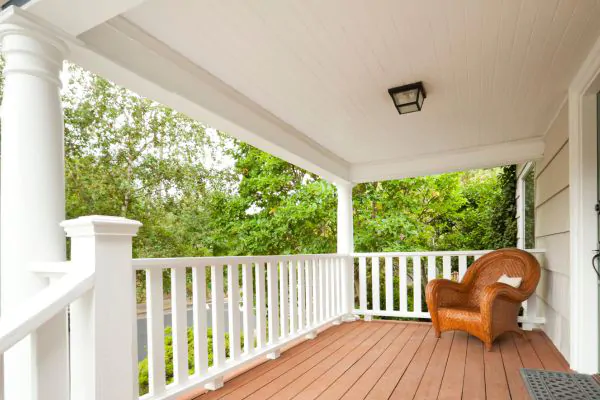
Choosing deck railing materials requires balancing safety, aesthetics, and budget constraints. Seeking cost-efficient alternatives that maintain quality and visual harmony, homeowners can opt for pressure-treated wood or economical metals, vinyl, or cable railings. These choices offer financial prudence without compromising the elegance and fortitude of the outdoor sanctuary.
Exploring budget-conscious alternatives in deck railing materials unveils pressure-treated wood as a sturdy, cost-effective choice, remarkably resistant to decay and insects. Meanwhile, using affordable metals, vinyl, and cable options presents thrifty yet stylish solutions that cater to diverse design intentions without straining the homeowner’s finances. These materials embody the principle of economic ingenuity, enabling a blend of resilience and aesthetic charm that aligns with prudent spending.
How to Maintain Your Deck Railings?
Deck railing maintenance, bridging safety and aesthetics, is paramount for homeowners. Diligent upkeep not only reinforces the protective function but also preserves visual integrity.
Proper cleaning and inspections prevent debris and wear, ensuring resilience against the elements. Protective finishes like sealants extend lifespan and enhance appearance. Timely address of issues averts extensive damage, ensuring enduring stability and safety.
This subsection details essential practices embodying a proactive approach to safeguarding functional and decorative aspects of deck railings.
A. Cleaning and Inspection
Meticulous cleaning and periodic inspection are the twin pillars of deck railing maintenance that ensure safety and enduring aesthetics. Removing debris such as leaves, dirt, and spider webs from railings prevents degradation and maintains a pristine appearance, while regular checks can expose any vulnerabilities or wear that necessitate immediate attention. This proactive regimen guarantees the structural and visual integrity of deck railings, solidifying their role as a safe and attractive aspect of any outdoor living space.
B. Protective Finishes
Deck railings endure as guardians of safety and ambassadors of aesthetic delight; their longevity hinging on how well they resist the relentless onslaught of weather and time. Sealants and coatings emerge as the invisible armor in this fight, a critical intervention homeowners apply to shield the intrinsic beauty of materials from moisture, sunlight, and decay. Mastery of their application—timely renewal, even coverage, and adherence to manufacturer’s guidelines—ensures deck railings continue to perform their dual role with grace and resilience.
C. Repairing and Replacing
Timely recognition of issues in deck railing systems is crucial, acting as a first line of defense in preserving safety and appeal. Spotting signs such as loose fittings, rotting wood, or corroded metal at an early stage can avert more significant concerns down the line. Homeowners must discern whether to execute repairs or, in cases where safety is compromised beyond remediation, undertake a full replacement to uphold the decking structure’s integrity and esthetic contribution to the property.
Troubleshooting Deck Railing Problems
Nesting safety and aesthetics within one’s outdoor sanctuary is intrinsic to homeownership. Over time, deck railings may reveal issues like wobbling or rusting metal components. Wooden railings might show decay, prompting a choice between repair and replacement. This subsection delves into troubleshooting common railing problems, ensuring these quintessential outdoor features’ continued safety, longevity, and visual appeal.
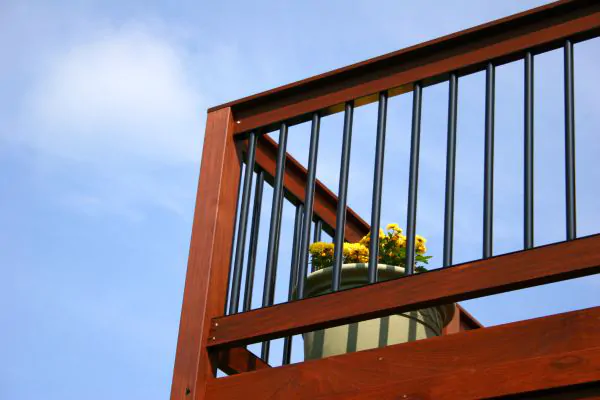
A. Wobbly Railing
Confronting a wobbly railing demands a strategic approach, often starting with tightening or replacing loose fasteners to secure connections and reinforce the structural framework.
Assessing support posts and anchorages and upgrading hardware for durability ensures resistance to environmental stresses.
Prioritizing safety through meticulous inspections detects any wobble or weakness. Professional services may be needed to correct underlying issues, guarantee required rigidity for occupant protection, and fortify trust in the deck as a secure outdoor haven.
B. Metal Rust and Corrosion
Preventing rust on metal deck railings involves applying rust-resistant coatings and regular cleaning to remove damaging salts and moisture.
Proactive homeowners deter extensive treatment, ensuring railings maintain structural fortitude and an unblemished appearance.
If corrosion appears, swift intervention is essential; sanding the affected area, applying a corrosion-inhibiting primer, and a fresh coat of paint can restore integrity and appearance.
These tips extend the lifespan of metal deck railings, preserving safety and polished presentation.
C. Wood Decay
Detecting decay in wooden deck railings requires vigilant observation for soft spots, discoloration, and splintering, indicating rot.
Immediate assessment is essential, as weakened structures pose a safety risk. Deciding between repair or replacement depends on the extent of decay and its impact on structural integrity. Targeted repairs may address minor issues, but extensive rot often requires complete replacement for safety and visual appeal in an outdoor living area.
Final Thoughts: Elevating Your Deck
In conclusion, the quest for an elevated deck experience culminates in the seamless blend of reliability and refinement. A well-calibrated railing system not only underscores a strong commitment to safety but also serves as the crowning stature of a deck’s aesthetic allure, solidifying the home as a sanctuary that gracefully unites form with function.






